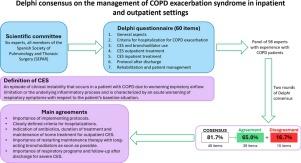Delphi Consensus on the Management of COPD Exacerbation Syndrome in Inpatient and Outpatient Settings
Q4 Medicine
引用次数: 0
Abstract
Introduction
COPD is a respiratory condition characterized by chronic airflow limitation. Exacerbations are an acute worsening of the symptoms. The objective of this study was to achieve a consensus on the management of COPD exacerbation syndrome in inpatient and outpatient settings.
Material and methods
A committee of experts developed a 60-item questionnaire to be agreed by a panel of experts, categorized into seven sections.
Results
After two rounds, consensus was reached on 81.7% of the items. Strong consensus (more than 85%) was reached on the importance of implementing protocols to help patients with exacerbations in both outpatient (92.7%) and inpatient (94.3%) settings. Regarding the criteria for hospitalization due to an exacerbation, respondents agreed that they are clearly defined (75.5%). Regarding bronchodilator use for CES, the only statement that did not achieve agreement was whether there are clinical differences between the use of nebulized rescue bronchodilators and pressurized metered-dose inhalers (pMDIs) with a spacer. Regarding CES treatment in the outpatient setting, consensus was reached for almost all statements, in contrast to what was found for inpatient treatment. Respondents disagreed with the statement that the use of SABA should be accompanied by the discontinuation of LAMAs or LABAs, with or without corticosteroids (74.8%). In the context of a COPD exacerbation requiring hospitalization, inhaled triple therapy should be prescribed (regardless of prior treatment) in the absence of contraindications. Regarding post-discharge protocols and rehabilitation, respondents reached consensus on all statements.
Conclusions
This Delphi consensus study provides valuable insights into the current management of CES, highlighting several areas where consensus remains elusive.

住院和门诊慢性阻塞性肺病加重综合征管理的德尔菲共识
copd是一种以慢性气流受限为特征的呼吸系统疾病。恶化是指症状的急性恶化。本研究的目的是就住院和门诊慢性阻塞性肺病加重综合征的管理达成共识。材料和方法一个专家委员会制定了一份60项的调查问卷,由一个专家小组同意,分为七个部分。结果经过两轮协商,81.7%的议题达成共识。在实施方案以帮助门诊(92.7%)和住院(94.3%)加重患者的重要性上达成了强烈的共识(超过85%)。关于因病情恶化而住院治疗的标准,受访者认为有明确的定义(75.5%)。关于支气管扩张剂在CES中的使用,唯一没有达成一致的说法是使用雾化急救支气管扩张剂和带间隔剂的加压计量吸入器(pmdi)是否存在临床差异。关于门诊环境中的CES治疗,几乎所有的陈述都达成了共识,与住院治疗的情况相反。应答者不同意使用SABA应同时停用LAMAs或LABAs,无论是否使用皮质类固醇(74.8%)。在需要住院治疗的慢性阻塞性肺病加重的情况下,在没有禁忌症的情况下,应开吸入三联疗法(无论先前是否接受过治疗)。关于出院后协议和康复,受访者对所有陈述达成共识。结论:德尔菲共识研究为当前的CES管理提供了有价值的见解,突出了共识仍然难以捉摸的几个领域。
本文章由计算机程序翻译,如有差异,请以英文原文为准。
求助全文
约1分钟内获得全文
求助全文
来源期刊

Open Respiratory Archives
Medicine-Pulmonary and Respiratory Medicine
CiteScore
1.10
自引率
0.00%
发文量
58
审稿时长
51 days
 求助内容:
求助内容: 应助结果提醒方式:
应助结果提醒方式:


